To boost profitability through menu engineering, analyze your sales data to spot top-selling items and classify each based on profit margins and popularity. Place high-margin dishes prominently using visual cues, strategic positioning, and appealing descriptions. Use menu psychology—like color, font, and layout—to influence choices, and consider dynamic pricing and upselling techniques. Continuously monitor performance metrics and leverage technology for real-time adjustments. Keep exploring to discover how to fine-tune your menu for maximum profit.
Key Takeaways
- Analyze sales data regularly to identify top-performing and underperforming menu items for strategic adjustments.
- Classify menu items into stars, puzzles, plowhorses, and dogs to optimize placement and promote high-margin dishes.
- Use visual cues, layout, and psychological techniques to highlight profitable items and influence customer choices.
- Incorporate dynamic pricing and seasonal promotions to maximize revenue and maintain menu relevance.
- Leverage digital analytics and AI tools for real-time monitoring and data-driven menu optimization.
Analyzing Sales Data to Identify Top-Performing Items
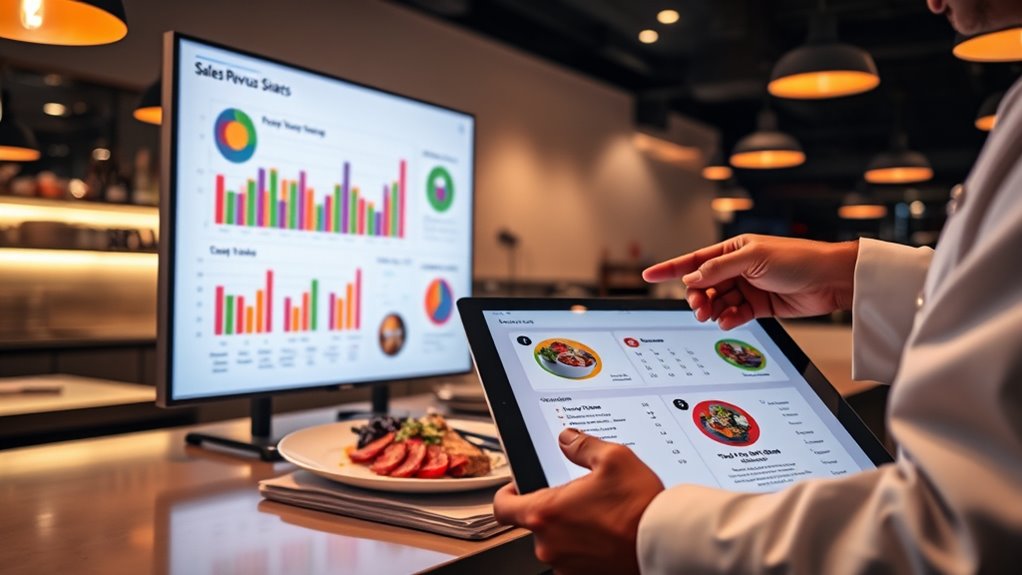
Analyzing sales data is essential for identifying your top-performing menu items. By reviewing sales patterns, you can determine which dishes attract the most customers and generate the highest revenue. This insight helps you optimize ingredient sourcing, making sure you stock ingredients for popular items without overordering less-used supplies. It also highlights areas where staff training is needed, so your team can better promote and prepare top sellers. Understanding sales trends allows you to adjust your menu strategically, focusing on profitable and popular options. Regularly analyzing this data keeps your menu fresh and aligned with customer preferences, boosting overall profitability. Staying proactive with sales insights ensures you maximize your menu’s potential and create a more efficient, customer-focused dining experience. Incorporating menu engineering techniques can further refine your offerings and enhance profitability.
Classifying Menu Items Based on Profit Margins and Popularity

How can you effectively categorize your menu items to maximize profitability and customer appeal? Start by analyzing your sales data to identify which dishes are both popular and profitable. Classify menu items into four groups: stars (high profit, high popularity), puzzles (high profit, low popularity), plowhorses (low profit, high popularity), and dogs (low profit, low popularity). This helps you focus on promoting high-margin items and consider adjusting or removing less profitable ones. Ingredient sourcing plays a role here—optimize sourcing to reduce costs for high-margin dishes. Staff training ensures your team understands the value of each category and can recommend the most profitable options confidently. Proper classification helps streamline your menu, increase sales, and boost overall profitability.
Strategically Placing High-Margin Dishes for Maximum Visibility
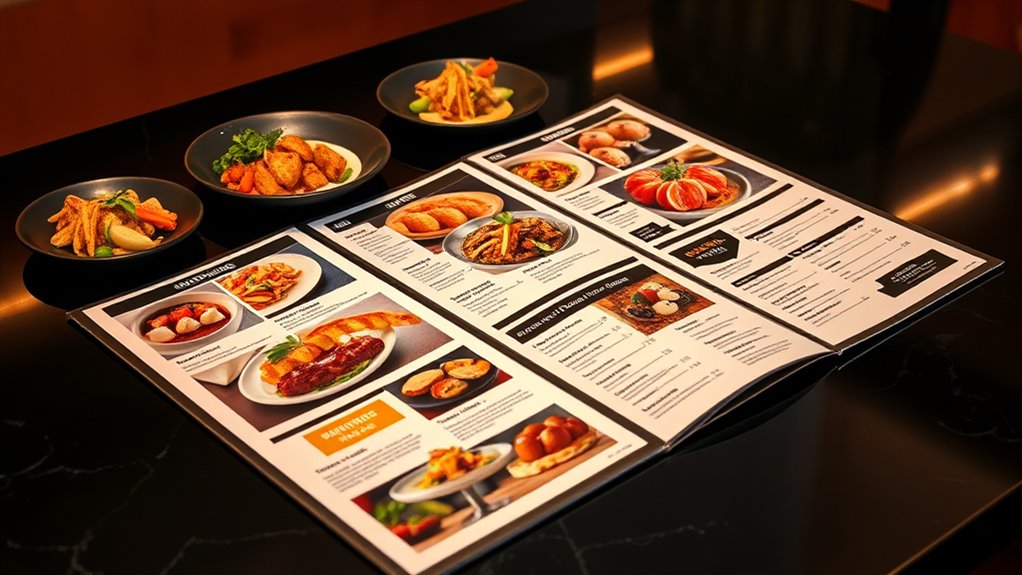
Once you’ve identified your high-margin dishes through menu analysis, the next step is to position them where customers’ eyes naturally land. Use your seasonal menu to highlight these items, placing them in prime spots like the top right or center of the menu, where attention is most focused. Incorporate clear allergen labeling nearby to build trust and reassure customers about ingredient safety. This strategic placement draws attention without overwhelming the menu’s overall design. Avoid cluttering these sections with other items, so high-margin dishes stand out. Consider using visual cues like boxes or different fonts to emphasize them further. Employing menu layout principles can help optimize placement for maximum impact. Employing psychological cues like color and font size can further enhance item visibility and influence customer choices. Additionally, understanding user preferences through analysis can help tailor placements to what customers find most appealing. Implementing financial considerations in menu design ensures that high-margin dishes are not only visible but also prioritized to maximize profitability. Moreover, integrating water-themed imagery or design elements subtly can create a calming atmosphere that encourages customers to explore these profitable options.
Utilizing Menu Psychology to Influence Customer Choices
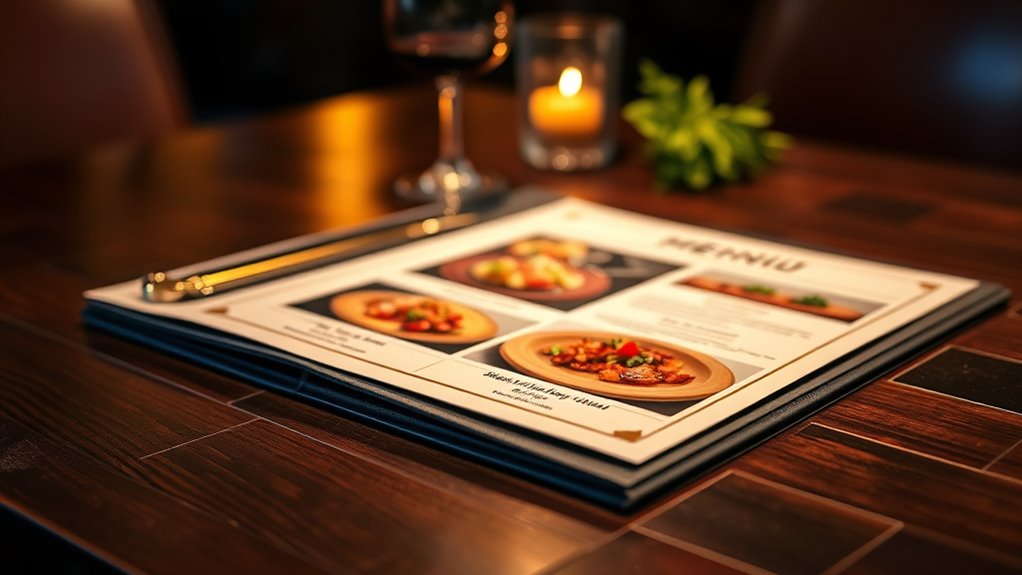
You can influence customer choices by using strategic placement tactics that draw attention to specific items. Appealing visual cues, like enticing images or highlighted descriptions, also encourage selections. When combined, these psychological strategies make your menu more effective at guiding decisions. Additionally, understanding cookie management and user preferences can help tailor digital menu experiences to enhance customer engagement. Recognizing menu psychology principles can further improve the effectiveness of your strategies by leveraging psychological cues that influence decision-making. Incorporating behavioral insights into your menu design can lead to higher sales and improved customer satisfaction, especially when aligning these techniques with exfoliation benefits that promote a refined and appealing presentation.
Strategic Placement Tactics
Have you ever noticed that certain items on a menu seem to catch your eye more than others? That’s no accident—it’s strategic placement. Your menu layout guides customer choices, highlighting high-profit items. Placing popular or profitable dishes where the eye naturally falls, like the top right corner, increases sales. Seating arrangements also influence ordering; guests tend to order what’s easily accessible. Use these tactics together to steer customers toward your best options. Here’s a quick breakdown:
| Placement Strategy | Focus Area | Effect |
|---|---|---|
| Prime menu spots | Top right, center page | Increased visibility |
| Highlighted items | Bold fonts, borders | Draws attention |
| Seating proximity | Near ordering stations | Encourages impulse buys |
| Visual hierarchy | Organized sections | Guides selection |
| Consistent layout | Clear, uncluttered design | Reduces choice fatigue |
Additionally, understanding customer behavior can help optimize your Hours Today List, ensuring your high-profit items are available when most needed. Recognizing how menu psychology influences choices can further enhance profitability by strategically aligning menu placement with customer tendencies. Implementing menu engineering techniques can optimize sales and improve overall revenue. Moreover, leveraging insights from Personality Traits can assist in tailoring menu designs to different customer segments, enhancing engagement and satisfaction. Incorporating knowledge of AI ethicist jobs and other emerging roles can also provide insights into how technology influences customer interactions and decision-making processes.
Appealing Visual Cues
Visual cues play an essential role in guiding your customers’ choices by tapping into their subconscious perceptions. Color psychology influences emotions; for example, warm colors like red can stimulate appetite and urgency, while green suggests freshness. Use these insights to highlight high-profit items or specials. Font selection also matters—bold, clean fonts catch attention and communicate clarity, while playful or ornate fonts may distract or confuse. Consistent, strategic use of color and font helps create a cohesive, appealing menu that directs focus naturally. By leveraging these visual cues effectively, you guide customers toward choices that maximize profitability. Remember, subtle cues like contrasting colors or emphasizing font styles can subtly influence purchasing decisions without overt pressure, making your menu both attractive and persuasive. Additionally, understanding how performance upgrades appeal to car enthusiasts enables you to incorporate relevant visual cues that attract the right audience. Incorporating principles from the Law of Attraction can also enhance your menu design by aligning your visual cues with your desired customer behaviors, creating a more magnetic and successful menu layout. Recognizing the importance of energetic alignment can help you craft a menu that resonates deeply with your target market and amplifies your profitability. For instance, using visual hierarchy techniques can further direct attention to your most profitable offerings and optimize sales.
Pricing Strategies to Maximize Profitability and Perceived Value

How you price menu items can substantially impact both your profitability and how customers perceive value. Implementing dynamic pricing allows you to adjust prices based on demand, time of day, or season, maximizing revenue during peak periods. Seasonal promotions attract customers during slower times and encourage repeat visits, boosting sales without permanently lowering prices. Strategic pricing also involves positioning high-margin items near the top of the menu and using psychological price points to influence choices. Avoid underpricing or overpricing; instead, focus on perceived value. By combining dynamic pricing with targeted seasonal promotions, you create a flexible pricing strategy that responds to market trends, enhances customer satisfaction, and increases profitability—all while maintaining an appealing perception of value. Additionally, leveraging smart pricing technology can help optimize your menu pricing in real-time based on customer behavior and demand patterns. Incorporating candy varieties and innovations, such as unique seasonal confections, can further differentiate your offerings and justify premium pricing. Employing productivity and time management tools can also streamline your menu planning process, ensuring timely updates to your pricing strategies and promotions. Exploring tea brewing knowledge can inspire creative menu items and pairing options that resonate with customers and support your pricing strategy.
Designing a Visual Hierarchy to Guide Customer Selections

You can influence customer choices by highlighting key menu items and placing them strategically. Using visual cues and icons draws attention and makes selections easier. When you design a clear visual hierarchy, you guide customers effortlessly toward your most profitable options.
Highlighted Menu Items
Have you ever noticed how some menu items immediately catch your eye? That’s the power of highlighted menu items. By emphasizing certain dishes through visual cues like boxes, different fonts, or color highlights, you direct customers’ attention. When designing these highlights, consider flavor pairing—pairing ingredients that complement each other makes the dish more appealing. Also, think about ingredient sourcing; showcasing fresh, high-quality ingredients can boost perceived value. Highlighting dishes with unique flavor combinations or premium ingredients signals to customers that these options are special. Use visual hierarchy to make these items stand out without overwhelming the menu. Strategic highlighting guides customer choices naturally, encouraging them to select high-profit dishes with greater confidence.
Strategic Placement Techniques
Strategic placement techniques use visual hierarchy to naturally guide customers toward high-profit and popular items. Carefully designing your menu layout helps highlight these options, making them more noticeable. Position your best-selling dishes and profitable items at the top right or center, where the eye tends to land first. Incorporate beverage pairing suggestions near main courses to enhance the dining experience and increase sales. Use spacing, font size, and bolding to create focal points that draw attention without clutter. For example, pairing a signature cocktail with a gourmet burger can boost beverage sales. Organize the menu in a way that directs customers smoothly, ensuring high-profit items are both prominent and easy to find.
| Position | Focus Area | Tip |
|---|---|---|
| Top right | High-profit items | Use bold fonts or boxes |
| Center | Popular dishes | Highlight with color or spacing |
| Near beverages | Beverage pairing | Place suggestions close to main items |
| Bottom left | Less profitable items | Minimize emphasis or reduce prominence |
| Overall layout | Visual hierarchy | Balance spacing, font size, and placement |
Visual Cues and Icons
Visual cues and icons are powerful tools for creating a clear visual hierarchy on your menu, guiding customers effortlessly toward high-profit and popular items. Use color psychology to highlight these options; warm colors like red or orange can stimulate appetite and draw attention. Incorporate icons such as stars or checkmarks to signal top choices or chef’s specials, making them stand out. Font choices also matter—bold or larger fonts can emphasize premium or high-margin dishes, while clean, simple fonts keep the menu easy to read. Consistency in icon style and color schemes helps reinforce your messaging. By strategically combining these visual cues, you direct customer focus naturally, encouraging selections that boost profitability without overwhelming or confusing them.
Incorporating Descriptive Language to Enhance Appeal

Using vivid, descriptive language on your menu can considerably boost a dish’s appeal by engaging customers’ senses and imagination. Highlighting seasonal ingredients creates a sense of freshness and timeliness that resonates with customer preferences. Instead of simply listing “salad,” describe it as “a crisp, invigorating mix of farm-fresh greens, ripe cherry tomatoes, and tangy vinaigrette, perfect for summer.” Use sensory words like “succulent,” “aromatic,” or “crispy” to evoke taste and smell. Incorporate storytelling elements to make dishes memorable. When you craft compelling descriptions tailored to what customers prefer, you make each item more enticing, encouraging them to order. This strategy not only enhances perceived value but also aligns menu offerings with current trends and seasonal highlights.
Upselling Techniques That Complement Your Menu Layout
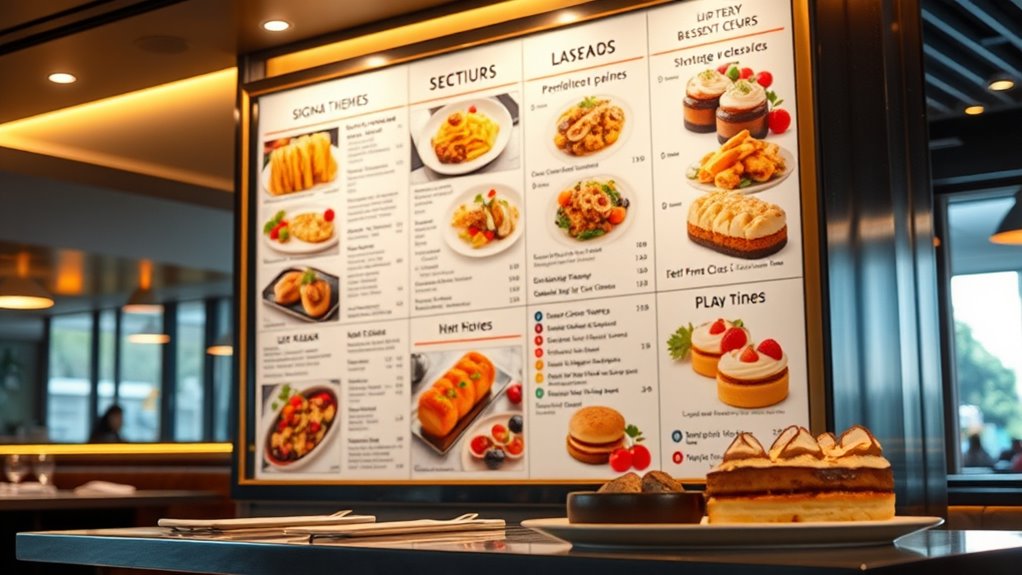
Enhancing your menu descriptions with vivid language naturally draws customers’ attention to specific dishes, but pairing that with effective upselling techniques can substantially boost sales. One powerful strategy is suggesting wine pairings that complement each dish, encouraging customers to upgrade their experience. Clearly indicate ideal wine options alongside menu items to make the choice effortless and appealing. Additionally, use portion control to guide upselling—offering larger portions or premium add-ons at strategic points can increase check averages. Train your staff to recommend these upgrades confidently, emphasizing how they enhance flavors and value. By integrating thoughtful wine pairings and portion control into your menu layout, you create natural opportunities for upselling without seeming pushy, ultimately driving higher profitability.
Monitoring and Adjusting Your Menu Based on Performance Metrics
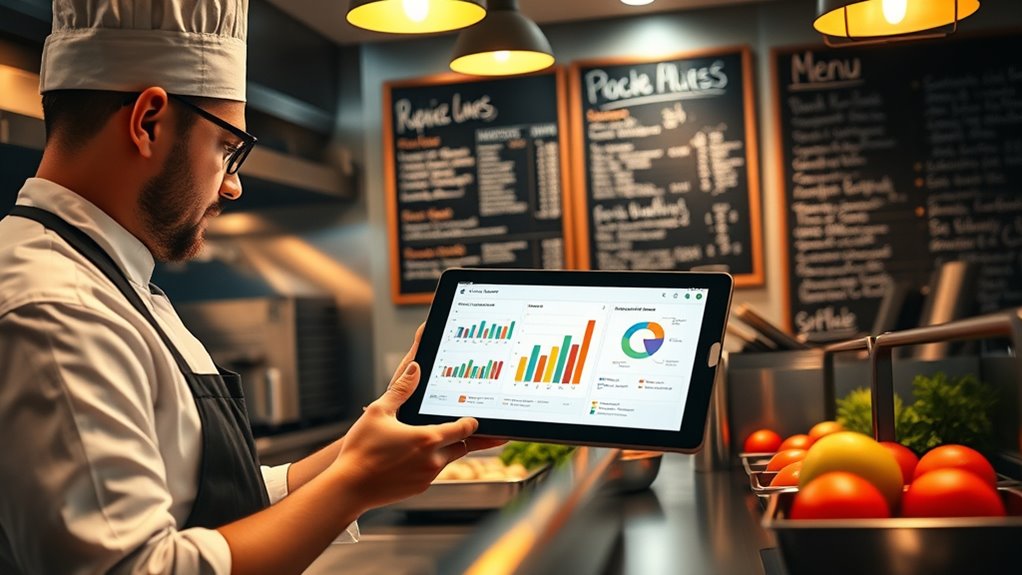
To effectively optimize your menu, you need to regularly monitor key performance metrics and make data-driven adjustments. Track sales data, profit margins, and customer preferences to identify which items perform well and which don’t. Use this information to refine your offerings, focusing on menu item innovation that appeals to your audience. Incorporate seasonal menu updates to keep your selection fresh and relevant, encouraging repeat visits. Pay attention to the popularity and profitability of each dish, adjusting prices or removing underperformers. Regularly reviewing these metrics helps you spot trends early and make strategic changes. This ongoing process guarantees your menu remains aligned with customer demand, maximizes profitability, and stays competitive in a dynamic market.
Leveraging Technology for Data-Driven Menu Optimization

Using technology can transform how you optimize your menu, giving you precise insights into customer preferences and sales patterns. Digital analytics tools and real-time sales tracking make it easier to identify top-performing items and adjust quickly. AI-powered adjustments can further refine your offerings, ensuring your menu stays aligned with demand and profitability.
Digital Menu Analytics Tools
Have you ever wondered how digital menu analytics tools can transform your restaurant’s menu strategies? These tools give you valuable insights through menu performance metrics, allowing you to identify which items attract customers and which ones underperform. With digital menu analytics tools, you can track sales data, popularity trends, and profit margins in real time. This data helps you make informed decisions about pricing, placement, and promotion to maximize profitability. Instead of guessing, you understand exactly what appeals to your guests and adjust your offerings accordingly. By leveraging technology, you gain a competitive edge, optimize your menu efficiently, and improve overall revenue. Digital menu analytics tools turn data into actionable insights, empowering you to craft a menu that’s both appealing and profitable.
Real-Time Sales Tracking
Real-time sales tracking empowers you to monitor your restaurant’s performance instantly, enabling swift adjustments to menu strategies. It provides immediate insights into which dishes are flying off the shelves and which aren’t, so you can:
- Boost profitability by promoting top sellers and removing slow-moving items.
- Improve inventory management, reducing waste and controlling costs.
- Respond quickly to customer feedback, refining menu offerings to match preferences.
- Identify patterns in sales trends, helping you anticipate demand and make informed decisions.
This technology ensures you stay agile, adapting your menu in real-time. By leveraging live data, you can optimize your offerings, increase customer satisfaction, and maximize profits—all while keeping inventory lean and aligned with customer desires.
AI-Powered Menu Adjustments
AI-powered tools are transforming how you optimize your menu by analyzing sales data and customer preferences with precision. These tools enable you to make data-driven adjustments to your menu design, ensuring it aligns with what your customers want. By identifying popular items and underperformers, you can highlight profitable options and reconfigure your layout for maximum impact. AI algorithms can also suggest personalized menu modifications based on real-time trends, helping you respond swiftly to changing customer preferences. This technology reduces guesswork, allowing you to craft a menu that appeals to your target audience while boosting profitability. Integrating AI into your menu strategy ensures that your offerings stay relevant, enticing, and optimized for both customer satisfaction and revenue growth.
Frequently Asked Questions
How Often Should I Update My Menu Based on Sales Trends?
You should update your menu based on sales trends regularly, ideally every 3 to 6 months. Conduct sales analysis to identify high- and low-performing items, then consider a menu redesign to highlight profitable dishes and remove underperformers. Staying current with trends guarantees your menu appeals to customers and maximizes profits. Frequent updates keep your offerings fresh and competitive, helping you adapt quickly to changing preferences and seasonal shifts.
What Are the Best Ways to Train Staff on Menu Upselling?
To effectively train your staff on upselling techniques, focus on boosting staff motivation through positive reinforcement and incentives. Teach them natural upselling techniques, like suggesting add-ons or premium options seamlessly during interactions. Conduct role-playing exercises to build confidence, and regularly review performance with feedback. When your team feels motivated and well-trained, they’ll naturally improve their upselling skills, leading to increased sales and better customer experiences.
How Can I Balance Menu Variety With Profitability?
You can balance menu diversity with profit maximization by carefully selecting a range of options that appeal to different customer preferences while highlighting high-margin items. Focus on offering variety without overwhelming your kitchen or customers, and organize your menu to emphasize profitable dishes. Regularly analyze sales data to identify top performers and adjust your menu accordingly, ensuring you provide enough variety to attract customers while maintaining healthy profit margins.
What Are Common Mistakes to Avoid in Menu Layout Design?
You might find yourself sidestepping common pitfalls in menu layout design. Avoid cluttering your menu with too much information, which leads to visual clutter, and steer clear of confusing navigation that frustrates customers. Keep it simple, clean, and intuitive. Use clear categories and logical flow, guiding your guests effortlessly. By doing so, you create a more inviting experience that encourages orders and boosts profitability without overwhelming your patrons.
How Do Seasonal Changes Affect Menu Engineering Strategies?
Seasonal changes impact your menu engineering strategies considerably. You should leverage seasonal ingredients to highlight fresh, appealing dishes, and adjust your menu to reflect what’s in peak season. During off-peak times, consider implementing off-peak pricing to attract customers and boost sales. By adapting your menu based on seasonal availability, you can optimize profitability and keep your offerings exciting and relevant throughout the year.
Conclusion
Think of your menu as a garden—you plant the right flowers, arrange them thoughtfully, and nurture what’s thriving. By analyzing your sales, positioning high-profit items, and using psychology, you’ll cultivate a lush landscape of profitability. Keep pruning and adjusting as seasons change, leveraging technology to guide your growth. With patience and care, your menu will flourish, attracting more customers and maximizing your bounty—turning your restaurant into a thriving, vibrant garden of success.









